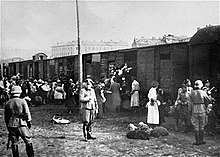Cattle wagon
Cattle wagon is a slang term for a railway wagon for transporting animals . Cattle were and are usually transported in covered or open freight cars .
Covered freight wagons , which are generally intended for the transport of weather-sensitive goods, were also intended for the transport of animals. Only for transporting racehorses were stables car used and for small livestock (sheep, goats, poultry and rabbits) were shed cars used. Cattle but also horses or pigs were transported in open freight cars ( high side gondolas ), formerly also known as horned cattle wagons. For the transportation of military horses in freight wagons, appropriate tie rings were provided. The transport of large and small livestock requires special precautions (ventilation flaps, fasteners, watering devices and inspection holes) in order to avoid quantitative and qualitative losses. Military teams were also transported in boxcars.
"Railway workers and railway enthusiasts reject ... the term 'cattle wagon' as one-sided". They refer to the multifunctionality of the freight wagon.
Holocaust and artistic processing

The term “cattle wagon” is often used in connection with the transport of Jews and “ Gypsies ” to concentration and extermination camps ; the cattle wagon has become a symbol of deportation and the Holocaust .
For the deportation of Jews from Germany to Litzmannstadt , Minsk , Kowno , Riga , the Lublin district and the Theresienstadt ghetto , the Reichsbahn initially used old 3rd class compartment cars from the 19th century until 1941/42 . In contrast, since the spring of 1942, the mass transports from the Generalgouvernement to the extermination camps and the deportations from the other occupied areas of Europe from France to Greece to Auschwitz were carried out almost without exception in covered freight wagons.
On April 19, 1943, the 20th deportation train set off from Mechelen in Belgium to Auschwitz. It was the first cattle wagon used by the Nazis because too many prisoners from the previous trains could jump out of the windows. The small window openings of the cattle wagon were nailed shut with wooden slats. On board this 20th transport were 1,631 people, mostly Jews, but also Sinti and Roma from northern France, the Pas-de-Calais . During the nightly attack on the 20th deportation train to Auschwitz near Boortmeerbeek, three Belgian resistance fighters helped 17 people to escape.
The term "cattle wagon" is used due to
- the perception of the survivors of the transports, which shapes the autobiographical representation and
- the character of these journeys (mass transports with killing sites as the destination as with slaughter cattle), which many participants did not survive, whereby the special conditions for survivors, historians and media editors of the topic suggest the analogy.
Covered freight wagons "have thus become an internationally widespread icon" for the National Socialist mass extermination "like the gate to the main camp Auschwitz". These human transports fell significantly below the standards for animal transports. People were transported more like general cargo .

Since 1983, when the use of a German freight wagon as the entrance gate to a Shoah museum in Dallas was reported, the subject began to be dealt with more intensively in Germany as well. The sculptor E. R. Nele dealt with the Holocaust theme several times in her work . The “ Die Rampe ” memorial stands in front of the University of Kassel .
See also
- Denk-Mal freight car
- Association design covered freight wagons
- Covered freight wagons of the interchangeable design
literature
- Alfred Gottwaldt : The German "cattle wagon" as a symbolic object in concentration camp memorials , in: Gedenkstättenrundbrief, No. 139 (October 2007), p. 18ff and No. 140 (December 2007), p. 3ff.
- Chapters "Towards with covered freight wagons" and "Transports with open freight wagons". In: Karolin Steinke: Trains to Ravensbrück. Transports with the Reichsbahn 1939–1945 . Series of publications by the Brandenburg Memorials Foundation , Volume 26. Metropol Verlag, Berlin 2009, pp. 57–63.
Web links
Individual evidence
- ↑ Transport of animals. In: Viktor von Röll (ed.): Encyclopedia of the Railway System . 2nd Edition. Volume 9: Seaport tariffs - transition curve . Urban & Schwarzenberg, Berlin / Vienna 1921, p. 319 ff.
- ↑ Freight wagons. In: Viktor von Röll (ed.): Encyclopedia of the Railway System . 2nd Edition. Volume 6: Freight Transport Crises . Urban & Schwarzenberg, Berlin / Vienna 1914, pp. 19 , 26f.
- ↑ Freight wagons. In: Viktor von Röll (ed.): Encyclopedia of the Railway System . 2nd Edition. Volume 6: Freight Transport Crises . Urban & Schwarzenberg, Berlin / Vienna 1914, p. 28 f.
- ↑ Alfred Gottwaldt, in: Gedenkstättenrundbrief No. 139 (October 2007), p. 24
- ^ Alfred Gottwaldt, in: Gedenkstättenrundbrief No. 139 (October 2007) (edited by the Topography of Terror Foundation), pp. 21/22
- ↑ Grenzgeschichte DG (German-speaking Community)
- ↑ Alfred Gottwaldt, in: Gedenkstättenrundbrief No. 139 (October 2007), p. 20
- ↑ Information and quotations from: Alfred Gottwaldt, in: Gedenkstättenrundbrief No. 139 (October 2007), p. 18ff .; see also: ders., The German freight car. An icon for the murder of Jews? In: Museumsjournal 13 (1999) H. 1; Karolin Steinke: Trains to Ravensbrück. About the permanent exhibition of the Ravensbrück memorial and the route of the goods wagon on display ... In: Contemporary history regional. Messages from Mecklenburg-Western Pomerania, 11 (2007) No. 1, pp. 103-105.
- ↑ “The» Cattle Wagons «in Museums and Memorials in Germany” on Memorial Forum
- ↑ Explanations on "Memorial Forum"